
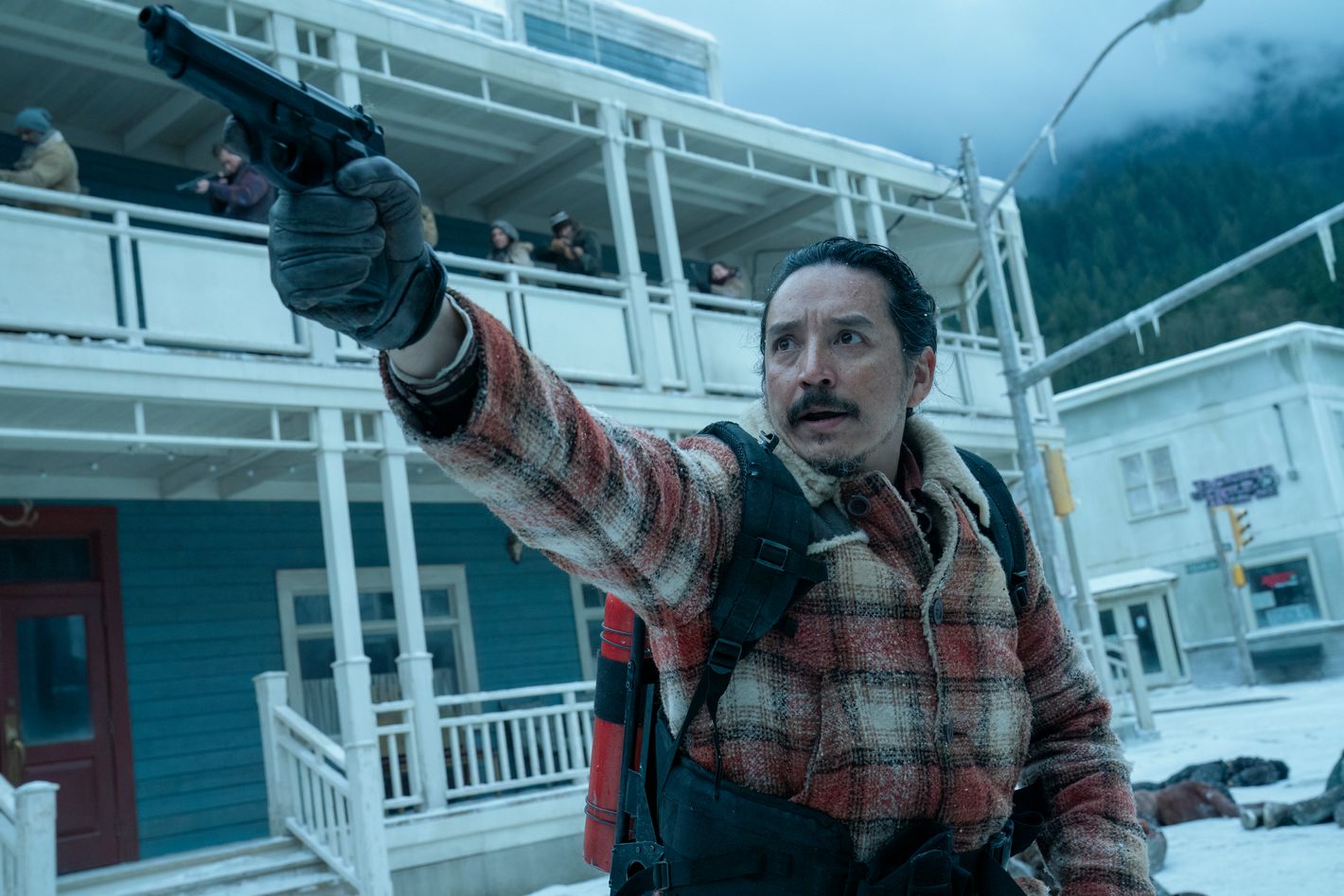
Spoilers follow for The Last of Us season-two episode “Through the Valley.”
Game of Thrones had “Hardhome.” Lord of the Rings, Helm’s Deep. The Last of Us, in a significant departure from the video games it’s based on, has Jackson.
In the second episode of season two, The Last of Us tackles the storyline gamers (or spoiler-friendly TV watchers) have anticipated for years: Joel’s death. Five years after slaughtering dozens of Fireflies to stop them from killing Ellie and harvesting her blood for a cordyceps vaccine, that decision comes back to haunt Joel in the form of Abby (Kaitlyn Dever), the daughter of the surgeon he mowed down to keep Ellie alive. Abby’s execution of Joel was always going to be this season’s biggest talking point. But “Through the Valley” isn’t just a story of Joel’s hubris, nor Ellie’s devastation as she endures his final moments. Through a siege on Jackson invented for the series, the episode serves as an elemental reminder of what our human heroes are still up against when it comes to the Infected. They’re smarter now, their numbers are getting bigger, and they attack Jackson like a natural disaster.
“We wanted to feel like everybody was wounded, that everybody was struggling with the sense of recovery and rebuilding,” says Craig Mazin, the series’s co-showrunner, who wrote “Through the Valley.” “In the game, Ellie is wounded, and we didn’t want to feel like everybody else was fine. The reason to bring the fight to Jackson was to create a sense of vulnerability for everyone.” The battle required nearly four weeks of filming, 200 more VFX shots than last season’s centerpiece battle, and a flamethrower sequence that gave star Gabriel Luna unsettling visions for weeks.
The Idea: ‘There is nowhere we can go to feel perfectly safe’
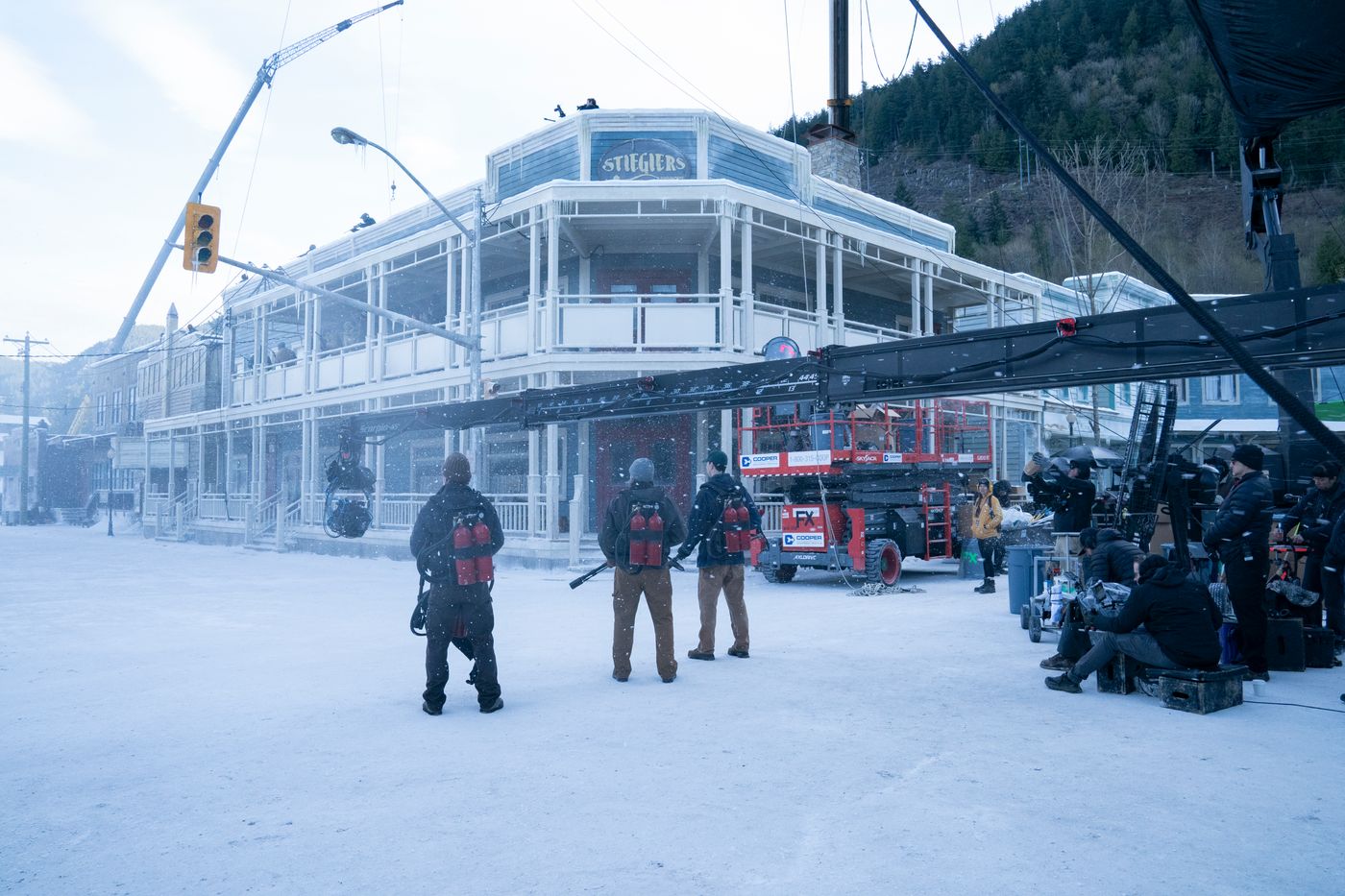
Season one developed Jackson more physically and narratively than in the game; in season two, the Wyoming outpost has grown even more, with refugees arriving almost daily. Jackson is now an idyllic, resourceful community, with a governing city council, pens full of livestock, and citizens who cycle through watch duty and patrol the surrounding areas. The audience needed a reminder that “there is nowhere we can go to feel perfectly safe,” Mazin says, and so he started thinking about how to disrupt Jackson’s tranquility.
While fleshing out side characters with more backstory and screen time, Mazin decided to change the person who would be with Joel when Abby attacks him. In the game, it’s his brother Tommy, but in the series it’s Dina (Isabela Merced), who expands from only Ellie’s love interest into more of a daughter figure to Joel. That freed up Tommy (Luna) for a larger storyline that reflected his authority in Jackson and emphasized his bond with wife Maria (Rutina Wesley). “To be incapacitated while his brother’s being beaten to death — that just didn’t hit right with me in my heart,” Luna says. “And Craig’s like, ‘Don’t worry. We’re thinking about some things.’”
As Mazin worked on season two before the WGA strike began in May 2023, he sent Luna what the actor describes as a “Bible-long text” that laid out a new idea: an attack in which all of Jackson would come together to fight off “a whole horde” while linking together numerous story threads. During her search for Joel outside of Jackson, Abby wakes up Infected who, now evolved enough to strategize, have been using their dead as insulation in the snowy mountains surrounding the town. Meanwhile, Jackson’s overly confident approach to growth activates a cordyceps network that had grown through the town’s pipes. Those two groups, led by a gigantic Bloater, then converge upon Jackson.
Maria, Tommy, and their neighbors must defend the town from hundreds of Infected — a battle that potentially could have been avoided if the Fireflies succeeded in making a vaccine from Ellie’s blood, Mazin notes. “It’s interesting to see how one person who makes a choice is being confronted by that choice, while a whole other bunch of people are feeling the direct and negative impact of that choice — not just one person, not just people that we don’t know or maybe don’t like, but people we love,” Mazin says of the parallels he drew between Joel’s death scene and the siege on Jackson. “There was value in pulling the rug out from under everybody, and to have a feeling at the end of that episode that everything had fallen apart.”
The Preparation: ‘Get their head around how massive this is’
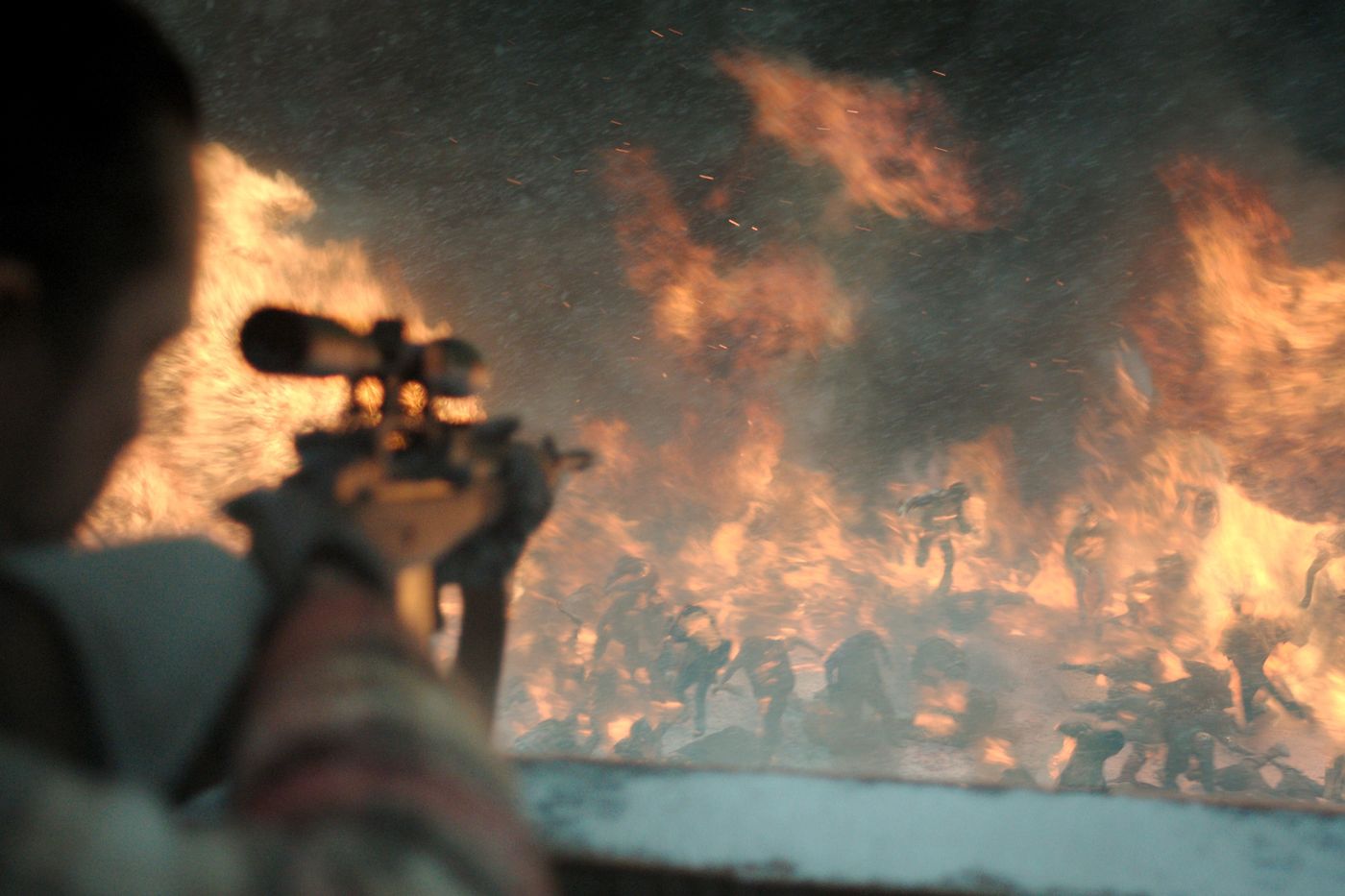
The creative team on The Last of Us already had a blueprint for a storyline involving a city attacked by a group of Infected and a gigantic Bloater: “Endure and Survive,” the Kansas City-set episode that included the first season’s largest action set piece. But the demands for the battle of Jackson far eclipsed that episode, say production designer Don Macauley and visual-effects supervisor Alex Wang. Jackson required an entirely new build on a parking lot in Vancouver, British Columbia, as well as more actors and stunt professionals on set, plus the battle was set during daytime, which made the more extensive VFX harder to hide. “That episode did become this separate show within our show,” Mazin says.
No materials from the first season’s version of Jackson, which was built in Canmore, Alberta, were retained when production moved to British Columbia for season two, so Macauley and his team had to construct a thriving Jackson from scratch before production started in February 2024. The final set measured 650 feet by 450 feet, or the equivalent of two full city blocks with cross streets, and included a wall, a gate, and 45 buildings built to various levels of internal finish. They didn’t use any signage from season one, like the Tipsy Bison bar’s shingle, to add to the feeling of Jackson’s growth and signal that the characters are in a different part of the town, says Macauley.
The new Jackson build was used in its completed incarnation for filming season-two premiere “Future Days,” but, “we knew there was a battle as we were building,” Macauley says. “Through the Valley” director Mark Mylod and cinematographer Catherine Goldschmidt storyboarded and mapped out the action on the standing set, then Macauley’s team went back in, reinforcing, fireproofing, and updating the gate with a movable section for the Infected to storm through after they breach the wall; retrofitting the buildings that would be set on fire with fireproof materials; finishing rooftops and adding catwalks so the cast and crew could easily access them for action sequences; and adding breakaway glass to windows the performers had to smash through. Macauley himself illustrated and colored every beat of the battle, complete with lighting, to serve as a reference for everyone on the production team. “They’re as close to a frame from the show as you can get without having shot anything,” he says. “Everyone sees those ahead of time so they can start to get their head around how massive this is.”
Meanwhile, Wang and his team of 11 VFX vendors worked from Mazin’s script to capture “the epicness and scale,” Wang says. The attack occurs during a blustery snowstorm that hampers visibility in the horde’s daytime assault, and most of the scenes required a VFX touch. In addition to extending Jackson’s protective wall and augmenting the fire spreading through town, the team expanded the dozens of stunt performers and 100 or so extras in prosthetics into a mob of a thousand Infected throwing their bodies on top of each other and attacking people as they careen through Main Street. “Craig had full expectations for us to showcase Infected full-on,” Wang says. “It was important to capture their animalistic and almost desperate motions.”
Particularly important was the episode’s primary villain, a Bloater that breaks through the Jackson wall and duels with Tommy in a dead-end alley. Like in season one, the Bloater would be fully CG, but Wang and Mazin decided the Jackson Bloater would be larger and more imposing. “Craig didn’t want it to feel like, ‘There’s just one Bloater and he travels across America, following them,’” Wang laughs. In total, the episode used 600-plus VFX shots, nearly 200 more than the season-one high for Kansas City.
The Performance: ‘Every round fired is a decision being made’
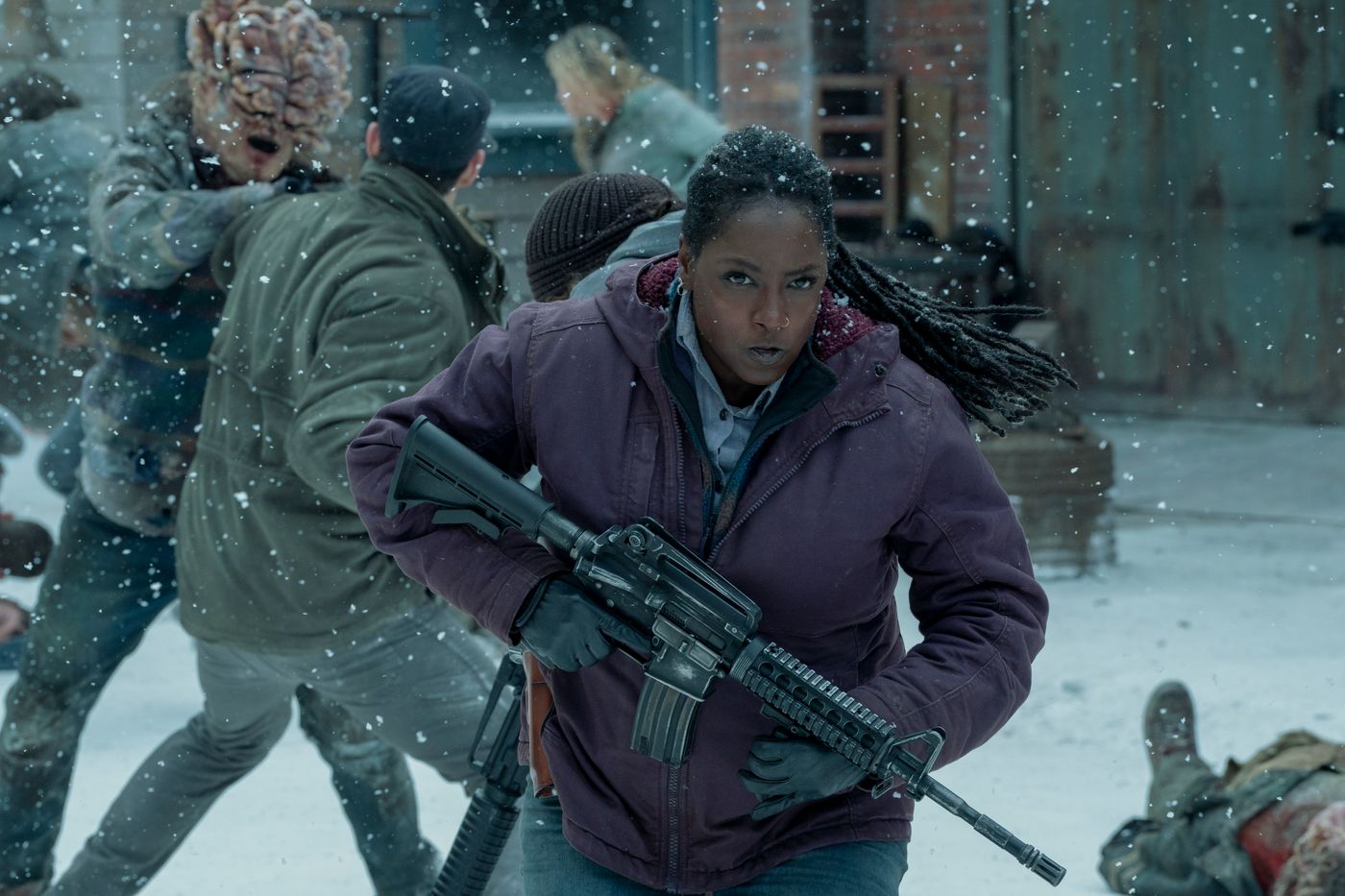
As the town realizes Infected are hiding in the snow, Jackson mobilizes to protect itself, and council members Tommy and Maria step up to guide the town’s citizens through their flares-and-bells warning system before forming a defensive formation. These scenes were meant to emphasize that Jackson’s community has become part of Tommy’s “new family,” Mazin says: He’s responsible for more than just his wife, son, and brother now. With Maria stationed on a rooftop as a sniper and Tommy directing action first from atop the town’s wall and later on the ground on Main Street, the battle is punctuated by shots of them looking for — and occasionally shooting to protect — each other in the chaos. “We’re anchors for each other. Even though he could barely see my face up there on the roof, he knew I was looking at him, and I was locked onto him,” Wesley says. “You get to tell the story through these very specific action story points,” adds Luna. “Everything you see on the screen is meaningful, and every round fired is a decision being made.”
Luna and Wesley went through stunt training and shooting practice with weapons built by the series’s armorers, including recreations of specific guns used in The Last of Us video games, like Tommy’s M1 Garand rifle. Macauley worked out the physics of certain sequences, like the moment when Jackson’s defenders roll gasoline barrels off the wall and into the horde. (“We had scaffolds set up with our chutes and stunt people getting hit with foam barrels in parking lots weeks in advance,” he says.)
Battle filming took place over nearly four weeks, with the sequence broken up into chunks. There were constants throughout this period: endless Canadian rain, bullet casings littering the top of the wall, and Dolomite, the substance used for fake snow (which Luna describes as ““white, flavorless Cheeto dust”) caked to the set. “I didn’t realize how hard it was going to be until I got there and I’m running around in cowboy boots,” jokes Luna. Within the episode, Wesley and Luna each get big stunt moments: She releases the dozen attack-trained German Shepherds who finally turn the tide against the Infected, he kills the Bloater with a flamethrower. In preparation, Luna learned how to shoot both fireballs and longer streams of flame, but in the moment, he says, he called on a childhood memory: witnessing a demonstration of a napalm flamethrower at the National Museum of the Pacific War. “They lit up this bunker, and they had to be at least 15, 20 meters away, yet the moment that the flamethrower ignites, you could feel the heat as if it was right next to you,” Luna remembers.
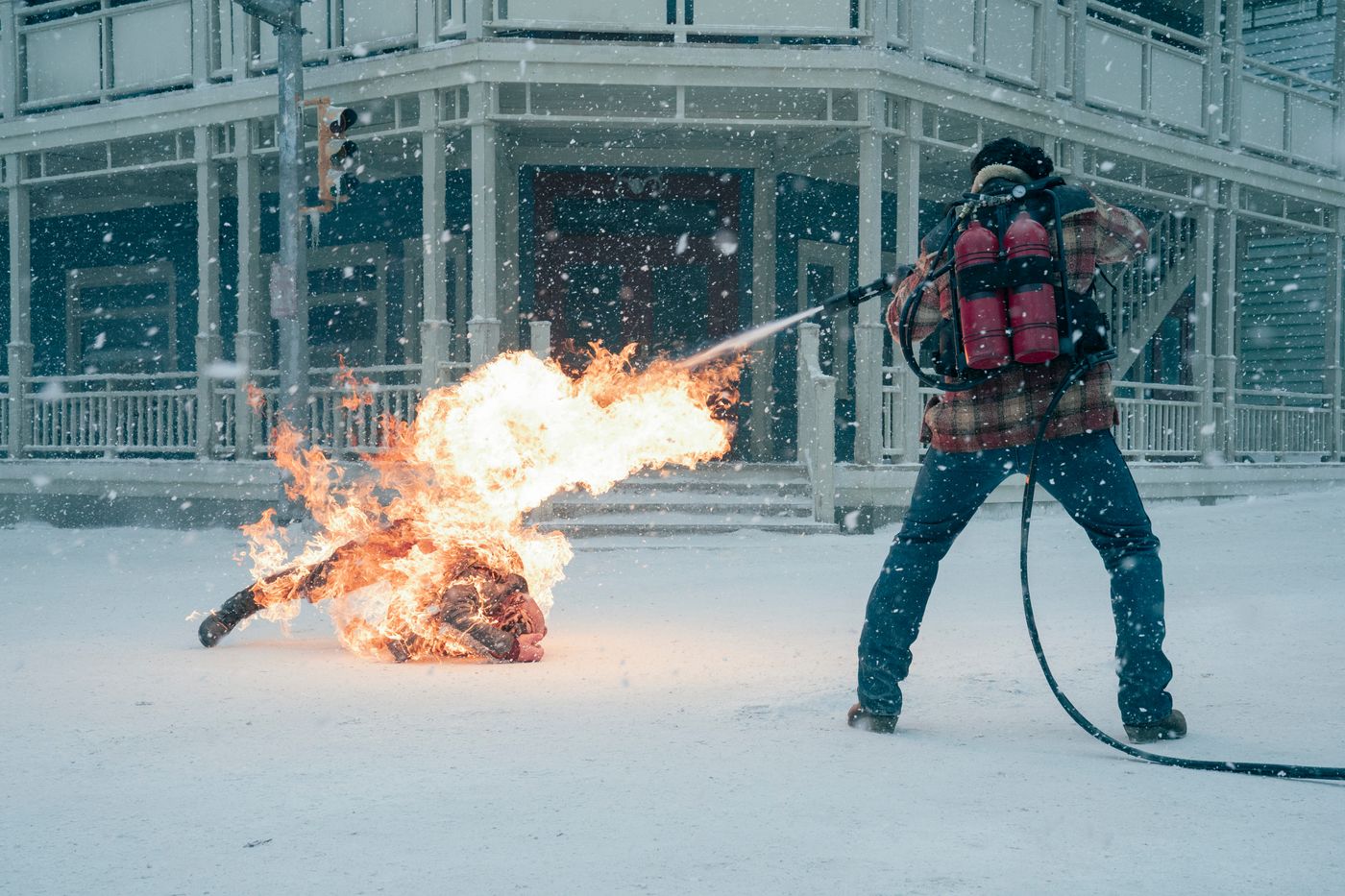
His own flamethrower experience on The Last of Us set was similarly sweltering — and completely reimagined after principal photography. Mazin and Macauley had a new idea: What if the Bloater pursued Tommy into a labyrinthine, dead-end alley, where Tommy had to make a last stand? And so, four months later, Luna returned to a freshly built area of the Jackson set to film another version of the face-off, this one ending with the Bloater collapsing at Tommy’s feet. Although the final Bloater is a CG creation, stunt actor Glenn Ennis, wearing platform boots and what Luna describes as a “helmet with a Teletubby antenna and green tennis ball,” stood in as a VFX reference as Luna blasted him with “12 or 13 full body burns.” The final scene is gnarly and brutal, and took a mental toll Luna didn’t expect: weeks of recurring visions of the figures he set on fire running toward him. “I always make a joke of it, and my wife’s like, ‘Baby, I think you’re traumatized,’” Luna says. “And I was like, ‘Yeah, you’re probably right.’”
“Through the Valley” ends on a broader question of healing, as Tommy and Maria embrace and survey what’s left of Jackson. How will the town rebuild after this attack, and how will they react to the news about Joel? In his original script, Mazin says, the episode cut back and forth between Jackson and Joel, an approach he changed in editing as he realized, “the moment Abby shoots Joel, you cannot leave that room. Our investment in Joel is so profound that we will not care about anything if we leave right there.” Instead, “Through the Valley” stays with the Jackson battle through the triumphant German Shepherd attack, then shifts to the chalet where Abby traps Joel as she reveals her identity, tortures him, and ultimately, forces Ellie to watch her kill him. The emotional roller coaster ends with a wide shot of Ellie and her patrol partner Jesse (Young Mazino) towing Joel’s body toward Jackson burning in the distance. The image captures the series’s pattern of where “there’s a victory … there is something else that falls apart,” Mazin says. “This is the frontier, and they figured things out, which means Jackson has a chance to win. The question is, at what cost?”

Latest News
For Sale! 2016 Sea Ray 350 Sundancer – $180,000
Reel Deal Yacht is pleased to feature a meticulously maintained 2016 Sea...
NFL fines Falcons and defensive coordinator Jeff Ulbrich following prank call to Shedeur Sanders
The Atlanta Falcons have been fined $250,000 and defensive coordinator Jeff Ulbrich...
Barcelona and Inter Milan draw 3-3 in thrilling first leg of their Champions League semifinal
Lamine Yamal’s curler that went in off the post after the teenager’s...
Atlanta’s Dyson Daniels wins the NBA’s most improved player award
Dyson Daniels’ emphasis on defense earned him a starting job in his...
Phoenix Mercury are heading into new era without Diana Taurasi and Brittney Griner
The Phoenix Mercury will open their first season in 21 years without...














Leave a comment